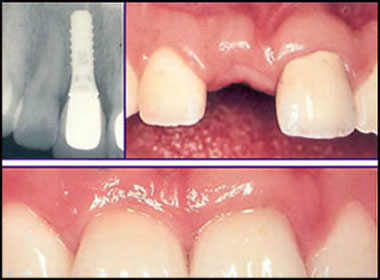Dental Implants—a Permanent Fix for Missing Teeth
Dental implants, rather than a fixed bridge or removable dentures, are an increasingly popular method of replacing teeth lost to an accident, gum diseases or Tooth decay.
In an interview in the January issue of Mayo Clinic Women’s HealthSource, Sreenivas Koka, D.D.S., Ph.D., chair of Mayo Clinic Department of Dental Specialties, discusses the advantages of dental implants and what’s involved.
To place an implant, an oral surgeon or periodontist cuts open the gum to expose the jawbone and then drills a small hole in the bone for the metal cylinder that serves as the implant. “It’s almost like drilling a screw into the wall,” says Dr. Koka. The patient is under anesthesia.
Over the next three months, the area heals and the implant fuses with the jawbone. Patients may undergo a second procedure in which a post, called an abutment, is attached or screwed down into the implant. This can be done at the same time the implant cylinder is put in or after the area has healed.
In the final step, the dentist attaches a realistic-looking artificial tooth to the implant or to the post. The entire process takes about four months.
 A big advantage, says Dr. Koka, is that an implant acts as a substitute for the roots of a natural tooth. “If you are missing a single tooth, this allows you to leave the other teeth around it alone,” says Dr. Koka. “With a bridge, you have to cut down the teeth on each side of the empty space so that a false tooth can be held in place by two crowns.”
A big advantage, says Dr. Koka, is that an implant acts as a substitute for the roots of a natural tooth. “If you are missing a single tooth, this allows you to leave the other teeth around it alone,” says Dr. Koka. “With a bridge, you have to cut down the teeth on each side of the empty space so that a false tooth can be held in place by two crowns.”
Almost any adult in reasonably good health is a candidate for dental implants.
 Dr. Koka says that patients often ask if osteoporosis would prevent them from getting dental implants. It doesn’t. Mayo Clinic research has shown that patients with osteoporosis or those taking oral bisphosphonates used to treat osteoporosis have about the same success rate as other patients. And the success rates for dental implants are high - 90 to 96 percent.
Dr. Koka says that patients often ask if osteoporosis would prevent them from getting dental implants. It doesn’t. Mayo Clinic research has shown that patients with osteoporosis or those taking oral bisphosphonates used to treat osteoporosis have about the same success rate as other patients. And the success rates for dental implants are high - 90 to 96 percent.
Mayo Clinic Women’s HealthSource is published monthly to help women enjoy healthier, more productive lives. Revenue from subscriptions is used to support medical research at Mayo Clinic.
Source: Mayo Clinic